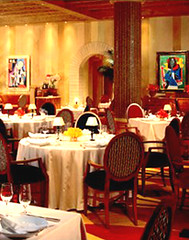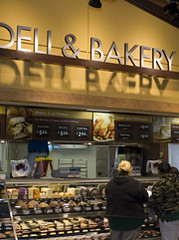After eating a late lunch at Claim Jumper yesterday, neither my son nor I felt all that well. As a former dining reviewer, it wasn’t hard for me to figure out that the food had waited too long on the hot plate before service; the same experience two other guests complained about before departing in a huff.
Social media can make you feel the same way sometimes. Undercooked entrees, poor service, or unrestrained comments leave you wondering why you dropped by to sample the menu (if there is one).
After following a link to Robert Scoble talking about the death of blogging (hat tip to Geoff Livingston’s take on content vs. contacts at BlogStraightTalk), I felt like I did after eating at Claim Jumper.
Sure, I like Scoble’s blog, but lately he seems to be serving up a different dish than what attracted me to begin with. And he hasn't been all that kind to some patrons either. As a “celebrity chef” of blogging, he might know better.
Rather than berate the point, maybe it would be more useful to remind everyone that like restaurants, there are several different culinary styles to social media. Whether you want it served up like fast food (social networks), hole-in-the-wall (undiscovered C-listers), established favorites (B-listers) or something gourmet (A-listers, while they are A-listers anyway), you can always find what you are looking for (and some days you want one more than the other).
But regardless of what kind of blog you have (ancient wisdom, tech and trendy, or fast and frenzied), the best bloggers, no matter what list they are supposedly on, always underpin what they have with some common sense. I could list a hundred or so who do it right. But rather than do that, I’ll share what Julian Serrano, executive chef at Picasso (Bellagio Hotel and Casino), and David Renna, then general manager at Renoir (The Mirage Hotel and Casino) shared with me when their experiences became the first Las Vegas restaurants to earn Mobil Travel Guide’s prestigious five star rating.
Julian Serrano, Picasso (2000)
1. Everyone must work hard and work together as a team. Everyone must think the same.
2. Everything must work together—the service, décor, and location—in order to give guests the best gastronomic experience possible.
3. You must have the best quality produce and products available. Nothing less will do.
4. Make each guest feel special and important.
5. You must provide good service, good food, and a good overall dining experience.
David Renna, Renoir (2000)
1. Surround yourself and your staff with the most talented people available.
2. You must have commitment from every member of the staff, whether it be the chef, waiter, steward or manager.
3. While it can often be a difficult and expensive task, producing the finest ingredients and wines from around the world makes a tremendous difference in the overall presentation and experience.
4. Service must be professional, and above all, personalized.
5. Every evening, every table, every guests. Create a seamless and hopefully flawless dining experience.
Now that is five-star dining (no wonder why I sometimes miss the assignments). And, not surprisingly, it also happens to be the recipe for social media success — surround yourself with talented contacts, make sure everything is working together, always provide the freshest ingredients, infuse some original content and ideas from around the world, and personalize the experience for guests as much as possible.
It seems to work. So much so that just like most restaurants, the ability to stay on top wth five stars (regardless of seating capacity) has a lot to do with serving substance over flash in the pan.

Social media can make you feel the same way sometimes. Undercooked entrees, poor service, or unrestrained comments leave you wondering why you dropped by to sample the menu (if there is one).
After following a link to Robert Scoble talking about the death of blogging (hat tip to Geoff Livingston’s take on content vs. contacts at BlogStraightTalk), I felt like I did after eating at Claim Jumper.
Sure, I like Scoble’s blog, but lately he seems to be serving up a different dish than what attracted me to begin with. And he hasn't been all that kind to some patrons either. As a “celebrity chef” of blogging, he might know better.
Rather than berate the point, maybe it would be more useful to remind everyone that like restaurants, there are several different culinary styles to social media. Whether you want it served up like fast food (social networks), hole-in-the-wall (undiscovered C-listers), established favorites (B-listers) or something gourmet (A-listers, while they are A-listers anyway), you can always find what you are looking for (and some days you want one more than the other).
But regardless of what kind of blog you have (ancient wisdom, tech and trendy, or fast and frenzied), the best bloggers, no matter what list they are supposedly on, always underpin what they have with some common sense. I could list a hundred or so who do it right. But rather than do that, I’ll share what Julian Serrano, executive chef at Picasso (Bellagio Hotel and Casino), and David Renna, then general manager at Renoir (The Mirage Hotel and Casino) shared with me when their experiences became the first Las Vegas restaurants to earn Mobil Travel Guide’s prestigious five star rating.
Julian Serrano, Picasso (2000)
1. Everyone must work hard and work together as a team. Everyone must think the same.
2. Everything must work together—the service, décor, and location—in order to give guests the best gastronomic experience possible.
3. You must have the best quality produce and products available. Nothing less will do.
4. Make each guest feel special and important.
5. You must provide good service, good food, and a good overall dining experience.
David Renna, Renoir (2000)
1. Surround yourself and your staff with the most talented people available.
2. You must have commitment from every member of the staff, whether it be the chef, waiter, steward or manager.
3. While it can often be a difficult and expensive task, producing the finest ingredients and wines from around the world makes a tremendous difference in the overall presentation and experience.
4. Service must be professional, and above all, personalized.
5. Every evening, every table, every guests. Create a seamless and hopefully flawless dining experience.
Now that is five-star dining (no wonder why I sometimes miss the assignments). And, not surprisingly, it also happens to be the recipe for social media success — surround yourself with talented contacts, make sure everything is working together, always provide the freshest ingredients, infuse some original content and ideas from around the world, and personalize the experience for guests as much as possible.
It seems to work. So much so that just like most restaurants, the ability to stay on top wth five stars (regardless of seating capacity) has a lot to do with serving substance over flash in the pan.




























